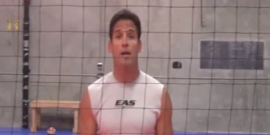 Learning volleyball blocking footwork is not easy, but it is very rewarding when done right. Hi, my name is Mike Diehl and I have been a professional indoor volleyball player for the past 15 years. I won the NCAA championship at UCLA in 1993, was the Bud-Light 4 Man MVP and First Team All-American at the 1989 Junior Olympics.
Learning volleyball blocking footwork is not easy, but it is very rewarding when done right. Hi, my name is Mike Diehl and I have been a professional indoor volleyball player for the past 15 years. I won the NCAA championship at UCLA in 1993, was the Bud-Light 4 Man MVP and First Team All-American at the 1989 Junior Olympics.
My motto for volleyball is from Wedding Crashers, “Rule #76: NO excuses, play like a champion!” The more you practice the better you get. Practicing how to properly block a volleyball can open many doors for you in the professional world of volleyball.
To get all twelve videos on volleyball blocking footwork become a member of volleyball1on1.com.
Read Queues
One of the most complex tasks in volleyball blocking footwork is being able to read queues. You must watch the setters back and read their body mannerisms to anticipate their next move. One of the most important suggestions I can give is to always watch the player not the ball! You should watch the player to see where the attackers shoulder is enabling you to anticipate where the ball will go and what their next move will be. Aim to attack the ball when going up for a block; do not just simply stop the ball.
Responsibility 1
The main responsibility as a blocker is to watch your footwork and stay in position with the opposing player in your position. Watching the setter and their hands allows you to anticipate where the ball will land and gives you the opportunity to plan your next move. As a blocker your hands should always be up and ready to block any and all spikes.
Responsibility 2
Keeping your hands straight up is critical! It ensures that you are prepared for any hit and are always ready to attack the ball. Your main responsibility is to block the hard driven balls and keep the opposing team from getting the kill. I recommend using a two step approach when blocking a pipe set. The two-step allows you to quickly get into position to make the block and watch your footwork.
Responsibility 3
Be careful not to over commit to the ball. Once the middle blocker starts to run behind, that is when you can take your steps over and become prepared to block. Get out to the antenna with a two step approach so you get there in minimum time and are ready to make the block.
Footwork 1
The two-step is not a very popular step anymore, but it is one of my favorites. The two-step is where you take one big step out and place your feet directly under your shoulders. This allows you to be ready for the block while doing minimum movement.
Footwork 2
A crossover step is a good step when trying to cover maximum space in minimum time. You start with your hands up and your weight on your inside foot. This allows you to tap jump off your right leg while taking your first step with your left foot. After you have taken the step with your left foot you will step over with your right foot and bring your left foot back around. Essentially you will step, push, crossover and jump straight up and over.
Footwork 3
Similar to the crossover, the swing block has the same footwork as the crossover except now you are swinging your arms forward and jumping up. If executed correctly your jump up should land in the same place as your take off.
Footwork 4 Cheat Steps
In your volleyball blocking footwork, taking a step off of the net before your opponents hit the ball allows you to be one step closer to being completely off the net. Once off the net you should put yourself into a position where you are able to prepare to play defense.
Hand Position: Waist Up
Along with your blocking footwork, your hands should always be up. Your hands should be about an elbows distance from the net allowing yourself to be able to always see the back of your hands. Your outside arm and hand should be in position with the outside blocker. Remember that your hand should be slightly turned in so the ball does not go out of bounds.
Position 2 – Part I
The first ball you’ll look for the is the back shoot set so you can assist the middle blocker with a quick tap jump. After that you’re responsible for the gap and back-row attacks. Finally you take the outside hitter. The outside hitter is mostly going to be hitting cross court. I cover more options in later videos.
Position 2 – Part II
Just like in position 4 start about five feet from the sideline so you can do a two step blocking approach. If you’re farther away from the sideline the double-two step approach like the Dutch players use is very effective. Some of the other steps you can use are the two-step swing block and the three-step swing block.
Position 2 – Part III
Like with position 4 you have to know the hitter’s attack arm and their line of approach. By watching the line of approach you can determine if they have only the cross court available to hit, or if they can hit line also. If you only watch the ball it will be past you before you can react. Keep the same distance from the net as in position 4 and be able to see the back of your hands so you can see what is happening and keep that outside hand strong.
You can get all my videos on volleyball blocking footwork plus more by being a member of volleyball1on1.com.








